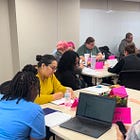Before reading this week’s Coaching Question, I encourage you to review some of the thinking around using exemplars.
The Coaching Question
“Who is the right exemplar for this moment?”
When to Use This Question
When introducing a new instructional strategy and looking for a model that inspires without overwhelming.
When the teacher does not have a clear understanding of what student work at the highest level looks like.
When teachers feel discouraged by high-performing exemplars that seem out of reach.
When a leader wants to strategically leverage early adopters to influence school-wide change.
When coaching a teacher who struggles with seeing how peer observation could benefit them.
The Problem This Question Aims to Solve
Exemplars can be powerful learning tools, but when misapplied, they can create comparison anxiety or discouragement rather than inspiration. Teachers may shut down if they believe a model is too advanced or unrelated to their current context. This question helps coaches and leaders select the right model to foster growth without intimidation.
The Research Behind It:
Vygotsky’s Zone of Proximal Development (1978) – Learning is most effective when it occurs just beyond a person’s current ability level. Choosing the right exemplar means selecting one that challenges without overwhelming.
Albert Bandura’s Social Learning Theory (1977) – People learn best through observation, but the effectiveness depends on how relatable and attainable the model is. This question ensures that exemplars feel accessible rather than unattainable.
Everett Rogers’ Diffusion of Innovations (2003) – Early adopters play a crucial role in scaling new ideas. Selecting the right exemplar means identifying models that will be most persuasive and motivating to different audiences.
Example Application in Coaching:
Scenario: A coach is working with a teacher who wants to execute a new strategy but seems hesitant.
Coach’s Response: “Who is the right exemplar for this moment?”
Teacher’s Reflection: “Maybe I need to see someone who used to struggle with the same thing, not just the best teacher in the building.”
Next Steps: The coach could arrange an observation with a teacher who recently made visible progress, reinforcing the idea that improvement is possible for everyone.
Additional Questions to Deepen the Conversation:
“What makes an exemplar feel relevant to your practice?”
“Would you learn more from someone at your level or someone far ahead?”
“How might observing a peer at a similar stage of growth help you?”
Final Reflection for Coaches and Leaders:
Choosing the right exemplar is as important as the instructional strategy itself. A well-selected model can accelerate learning, while an overwhelming one can cause disengagement. By asking this question, we ensure that exemplars serve as inspiration rather than discouragement, creating a culture where growth feels possible for everyone.








